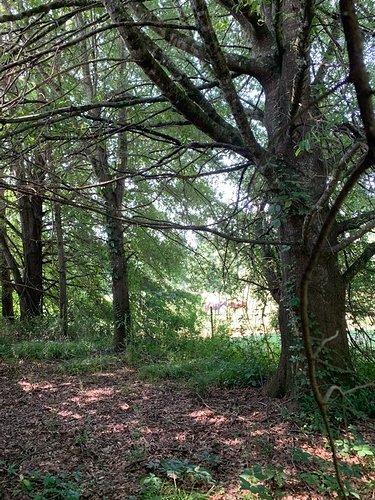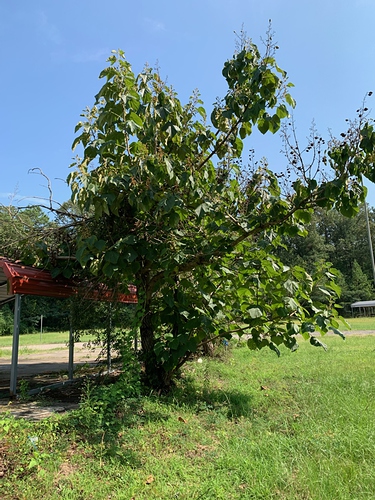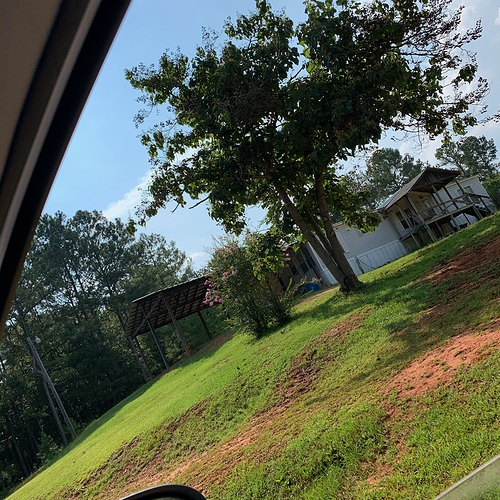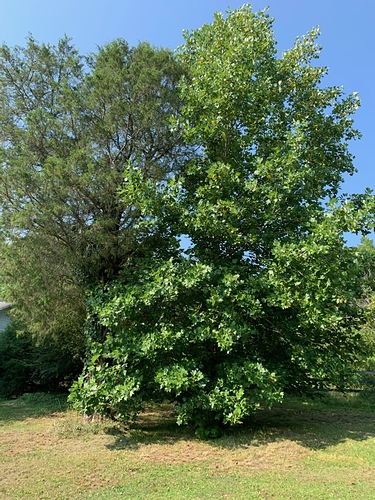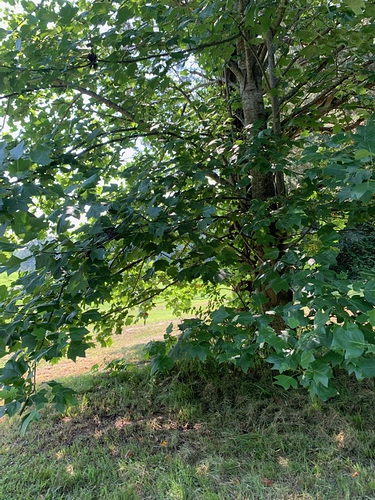Fair enough!
I didn’t realize catalpas are native; for some reason I thought they were non-native. Probably because they can sometimes become a “nuisance” tree; there’s also a Chinese variety sold for ornamental purposes that looks like could be where I got my misconception of it being invasive.
They can be a bit messy but grow on the faster side with a great canopy.
I’ll give a shout out to black birch:
https://plants.ces.ncsu.edu/plants/betula-lenta/
We have a ton of these and they’re pretty trees. (It took me forever to figure out what they were, they don’t have the papery bark I think of with birch.) They are apparently fast growers when young. They don’t seem to drop a bunch of branches, or nuts, and are overall pretty disease and bug resistant. They’re not toxic to horses. I would guess the wintergreen in them deters chewing?
It’s a mine field trying to find trees without bug or disease issues. Dutch elm disease took out all the elms. The ash borer beetle has taken out all the ash. Anthracnose doesn’t seem to actually kill most sycamores, but it sure makes them look naked and sad. Our beech trees are all dying of beech leaf disease, and it’s just amazing how fast it’s moving. 
I have a “disease resistant” elm (purchased and planted about 20 years ago).
It is still perfectly healthy, but it doesn’t grow very fast, and is tall rather than wide, so it doesn’t produce a large shade area.
We had two amazing American Elm trees in the pasture at a property we rented (you can just barely see the leaves of the second at the left). The horses loved them.
I’m not sure if they had lucky genetics and were disease resistant or if they were just isolated enough to survive.
Did I mention they were OLD??? There were tombstones grown into the one from the 1600s. I suspect those tombstones were not in their original location, but they were by that tree for a very long time regardless.
There was also an old American Chestnut tree on the property that was thriving until it rapidly died almost overnight.
Well, you just called me a liar, which I do not like. But my land-grant university educated landscape designer tells me that this catch-up phase for a small tree to become equal to the larger relocated one takes about a decade. I suppose it really depends upon how many years you are willing to wait for shade.
I didn’t call you a liar, I stated what is commonly understood about planting trees. This is supported by the Morton Arboretum, along with many others.
If you want your tree big and are willing to pay more for it and for it to be planted, go ahead. I’m not sure why you’ve taken such offense?
I can only go by my experience and my 12 inch bareroot trees quickly surpassed the 8 foot ones from Lowes. It did not take a decade. Like I noted - the limiting factor in tree growth is usually water and by placing the gutter tubing where I did my bareroot trees probably got more water than the other willow oaks. Same trees, same soil. And now at 20 years post planting the diameter circumference is twice what the once larger trees are now. And the bare root trees are much taller too.
The tree on the right is one of the original bareroot trees and to the left of it is a Shumard oak that was a large tree when planted. Now they are different types of oaks and willow oaks are faster growing but you can tell which one had the gutter tubing running out next to it and which one didn’t.
OK - Paulownias in all their glory. No - I didn’t just take pictures of the Ugly-Ass ones, they all pretty much look like this around here. I do admit the one 4horses posted a picture of doesn’t look like these do. Maybe a different variety? Better care? These were planted maybe 15 or so years ago. Not much shade.
.Compare to the tulip poplar I planted in my pasture about the same time.
In fact better shade than the rest of the trees I have planted here including the oak trees. I haven’t had problems with it being a brittle tree and storm damage but maybe it is not old enough to be giving me problems. Pine trees are another good shade tree if you plant a grove of them and they are fast growing and horses do not seem to eat them.
Good thought! Black Birch is an underutilized tree! One of my favorites. Not sure where OP is though, the birches struggle as you get farther south. Here in CT we are at the southern end of the range for the Yellow Birch and the Black doesn’t get much farther down.
I have several gorgeous Black Birches on my hedgerows.
Still like our huge willow tree. lol
Wow it looks like tree choices are greatly limited.

I definitely don’t recommend the Hemlock. Both Wooly Adelgid and Brown Scale have absolutely hammered hemlocks. Unless you are in a very cold, wet, north facing pocket of a hill Hemlocks are going to struggle anywhere south of New England. And even here they are in terminal decline. You can keep them healthy, if you you want to regularly treat them with some pretty heavy duty insecticides.
And ugh they drop branches like crazy anyway. Such messy trees, not a fan at all (and we have a ton!  )
)
This is actually probably why I (incorrectly) believe sycamores are slow growers. I compared them to the catalpa and was surprised to see the sycamores classified as rapid growth in some catalogs, while catalpas were only medium to fast growth. But anthracnose is really prevalent in my area and stunts the young sycamores pretty severely. They never seem to mature anywhere close the magnificent 100+ year old ones that dot the countryside and line city streets.
@SusanO Paulownias grow kind of low and scraggly like that in the wild. They aren’t particularly big trees. I don’t know if it’s certain varieties or pruning or what that people do to encourage them to grow straight with a full crown.
But their flowers in the spring are among my favorite.
This thread has me excited to plant some trees when it’s not scorching July temps!
Contact your local Conservation District/Extension office for their recommendations.
Wow, so many great suggestions! I’m leaning towards the Tulip Poplar. I know they do well here and it will be in full sun, which it seems to like. It will be in an area that is regularly mowed, so I’m not worried about seedlings popping up.
Just know they’ll pop up well away from the tree. I regularly find then 100s of feet from the edge of the canopy. But they’re easy to pull when small


